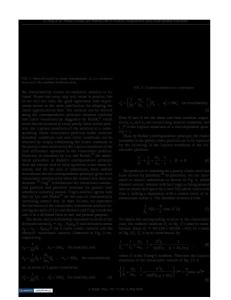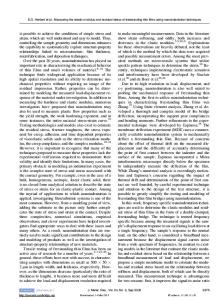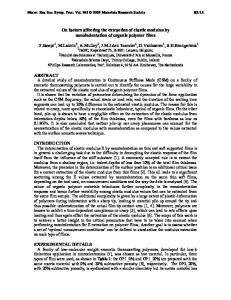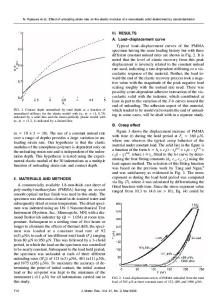The Effects of Creep on Elastic Modulus Measurement Using Nanoindentation
- PDF / 96,910 Bytes
- 6 Pages / 612 x 792 pts (letter) Page_size
- 110 Downloads / 456 Views
The Effects of Creep on Elastic Modulus Measurement using Nanoindentation G. Feng and A.H.W. Ngan Department of Mechanical Engineering, The University of Hong Kong Pokfulam Road, Hong Kong, P.R. China ABSTRACT During the unloading segment of nanoindentation, time dependent displacement (TDD) accompanies elastic deformation. Consequently the modulus calculated by the Oliver-Pharr scheme can be overestimated. In this paper we present evidences for the influence of the measured modulus by TDD. A modification method is also presented to correct for the effects of TDD by extrapolating the TDD law in the holding process to the beginning of the unloading process. Using this method, the appropriate holding time and unloading rate can be estimated for nanoindentation test to minimise the effects of TDD. The elastic moduli of three materials computed by the modification method are compared with the results without considering the TDD effects.
INTRODUCTION Load and displacement sensing nanoindentation is a convenient method for determining the mechanical properties such as hardness and elastic modulus of materials in small volumes [1,2]. The testing methodology given by Oliver and Pharr is most widely used [1]. In this method, the elastic modulus is obtained by analysing the unloading segment as a purely elastic recovery process. However, there should also be time dependent deformation (TDD), including indentation creep [3-6], thermal drift, and viscoelasticity. TDD can affect the accuracy of the measured modulus. Since the indentation creep rate decreases with holding time under the maximum load, the effect of indentation creep can be minimised provided a long enough holding time is used. However, as shown in Fig. 1, we found that, in the materials that we have studied at least, the indentation creep is still not diminished but approaches a constant rate even though the holding time is over 600s. In this paper, we propose a method to correct for the TDD effects, and apply it to analyse data obtained from single crystal Ni3Al, single crystal copper, and polycrystalline Al.
THEORY In a typical indentation test to measure the modulus of the specimen, the load schedule would comprise a loading segment during which the indentation load is increased to a maximum value, followed by a holding segment when the load is held constant at the peak value, and then an unloading segment to decrease the load. In the Oliver-Pharr scheme, the reduced modulus Er is given by
Q7.1.1
Er =
π S 2 Ac
(1)
where S is the initial unloading contact stiffness, and Ac is the contact area. 0.020nm/s Al data 1/3 h=hi+β(t-ti) +Kt
600 590
h(nm)
h(nm)
a) 2
R =0.99753 hi = 568.66 ±0.03 β = 2.94 ±0.01 ti = 237.32 ±0.05 K = 0.0062 ±0.0001
580 570 200
400
600 t(s)
Ni3Al data
0.0093nm/s h=h i+β(t-ti) +Kt
200
1/3
b)
195 2
R =0.99013 hi = 184.754 ±0.022 β = 1.320 ±0.010 ti = 274.927 ±0.096 K = 0.00315 ±0.00009
190 185
800
300 450 600 750 900 t(s)
Figure 1. The displacement-time curve of the holding process after correction of thermal drift fo
Data Loading...











